抑郁症是一种表现为长期、持续的情绪消极,兴趣缺乏的情感障碍[1]。随着人们受到的压力增大,抑郁症的患病率也在持续攀升,据世卫组织数据统计,预计至2030年,抑郁症总病例数或将超越各类心血管疾病的患者数量总和[2]。尚未有研究与理论可充分清晰的阐明抑郁症的发病原理,目前被广泛认可的理论是单胺学说[3]。该学说认为由于神经递质例如5-羟色胺与去甲肾上腺素等的水平降低而引起抑郁,据此研发提高两者水平的抑郁调节药物,但此类药物仅仅有益于部分患者,并且患者可能出现耐药性等反应[4]。因此,通过食品中营养物质干预调节抑郁症,并开发高效、对人体无毒害与副作用的抑郁调节营养体系成为了人们关注的重点。近年来,研究发现许多食品例如桔梗[5]、黄花菜[6]、肉豆蔻[7]等具有缓解抑郁症的功能。
人类肠道中微生物数量繁多、群落复杂且种属丰富,影响着人们的健康[8]。有研究表明,许多疾病的产生都与肠道菌群失衡有关,其与抑郁症之间通过“脑-肠-微生物”轴相互影响[9-11]。据研究证实,大脑海马区域中脑源性神经营养因子(brain-derived neurotrophic factor,BDNF)在肠道菌群变化后也会发生一定程度上的改变[12]。BDNF可促进脑细胞与神经的生长,当BDNF的表达下调时引起神经再生下降,从而导致抑郁相关症状;当BDNF表达水平提高时,海马神经元的损伤得到恢复,可改善认知和情绪[13]。研究表明乳酸菌与双歧杆菌可通过改变肠道组成和肠道菌群多样性、降低炎症因子、调节中枢神经系统等机制缓解抑郁症[14]。
黑果腺肋花楸(Aronia melanocarpa,简称黑果)是一种食用浆果,多酚含量在现有报道植物中居于首位,多酚主要为原花青素、酚酸等,具有抗氧化、免疫调节、抗炎等多种功效[15,16]。据报道多酚可通过抑制脑组织氧化应激反应改善慢性不可预知应激引起的小鼠抑郁[17,18]。此外,多酚肠道菌群代谢物还具有促进心理状况的功效[19]。黑果在食品加工行业中的应用主要集中与制作果汁[20]和酿造果酒[21]等,此外有研究表明黑果多酚还具有改善糖尿病[22]、改善高血压[23]、抗癌[24]等功能,但对其在抑郁症肠道菌群与脑神经等影响效果和机制未有报道。因此,本文以黑果多酚提取物为原料,探究其对抑郁症小鼠肠道菌群与BDNF影响作用,揭示其对抑郁症小鼠调节机理,探索黑果作为功能性食品的高值化开发价值和发展前景,以期为拓宽黑果的应用领域,提升其经济价值,更好地为人们的健康提供资源和思路,进而创造更大的社会效益。
1 材料与方法
1.1 材料
1.1.1 黑果多酚提取物与试剂
黑果取自淄博市铁山林场。皮质酮由江苏佳尔科药业集团有限公司提供;氟西汀由山东西亚化学工业有限公司提供;碳酸钠购自阿拉丁化学试剂公司;没食子酸标准品、福林酚试剂等其它常用试剂购自上海爱纯生物科技有限公司。
1.1.2 实验动物
BALB/C雄性健康小鼠,生产许可证号SCK(鲁) 2014-0007,质量18~22 g,7~8周龄,配套标准饲料与垫料由济南金丰实验动物有限公司提供。
1.1.3 主要仪器设备
FD-1A-50冷冻干燥机,杭州聚同电子有限公司;酶标仪,飞世尔(上海)仪器有限公司;SDS-PAGE凝胶电泳仪,BIO-RAD公司。
1.2 主要实验方法
1.2.1 黑果多酚提取
以黑果果实(叶)为原料,提取制备多酚,将新鲜黑果果实(叶)洗净,打浆。称取5 g浆液按照1:5料液比添加适量50%乙醇超声40 min,抽滤,滤液在50 ℃条件下减压除去乙醇,经冻干后冷冻保存,备用。
1.2.2 黑果多酚含量的测定
采用福林酚法[25]测定多酚的含量,并稍做修改,标准液为没食子酸,在765 nm处测定其吸光度。
配制1 mg/mL冻干黑果多酚提取物,其他操作同上。
标准曲线y=0.397x-0.0001,r=0.99测得黑果果实和黑果叶子多酚含量分别为19.59、18.60 mg/g。
1.2.3 抑郁症小鼠模型的建立
90只健康雄性的BALB/C小鼠随机平均分为9组。对照组(D)为健康小鼠以灌胃方式给与0.20 mL的生理盐水;模型组(M)通过注射0.20 mL、4 mg/mL皮质酮建立抑郁症小鼠模型;药物组(阳性对照组Y)皮下注射0.20 mL、4 mg/mL皮质酮和0.20 mL氟西汀;黑果果实多酚提取物低、中、高剂量组分别皮下注射0.20 mL、4 mg/mL皮质酮与以灌胃方式给与40、60、80 mg/kg黑果果实多酚提取物(HGd、HGz、HGg);黑果叶子低、中、高剂量组分别皮下注射0.20 mL、4 mg/mL皮质酮与以灌胃方式给与15、22.50、30 mg/kg黑果叶子多酚提取物(HYd、HYz、HYg)。所有小鼠每天给与一次药物注射与黑果多酚灌胃,4周后进行动物行为实验。
1.2.4 行为学实验
1.2.4.1 强迫游泳实验
小鼠于水深12 cm(水温约为22~25 ℃)容器中。实验时长为6 min,记录3~6 min小鼠累计不动的时间[26]。
1.2.4.2 糖水偏好实验
实验开始前48 h对小鼠先进行一次糖水偏好训练。每个鼠笼中都预先放置纯净水和1%的蔗糖水,每次间隔0.50 d互换水瓶的位置。训练完毕,小鼠禁止进食24 h后,自由饮用6 h,统计每只小鼠的纯水和蔗糖水饮用重量。糖水偏爱率=糖水消耗重量/(糖水消耗重量+纯水消耗重量)×100%[27]。
1.2.4.3 悬尾实验
将小鼠尾巴末梢固定于杆上,使小鼠处于头部朝下倒挂,使头部与地面相差约50 cm,周围用白色塑料板隔离。实验时长6 min,记录3~6 min小鼠累计的不动时间[28]。
1.2.5 大鼠肠道菌群测定
实验结束,将小鼠粪便存入灭菌EP管中,并置于液氮中冻存。肠道菌群多样性、菌群群落、主成分等委托上海美吉生物医药科技有限公司测定。
1.2.6 BDNF测定
小鼠脱颈致死,无菌环境下取大脑皮层底部海马组织,采用王赛等[29]的实验方法并稍做修改测定小鼠大脑BDNF水平。
试验结束后按照学校实验卫生要求,将废弃物集中暂存在实验室中,由学校统一集中处理。
1.3 数据分析
每组做3个平行。利用SPSS 19数据分析,Origin 8.5作图。
2 结果与讨论
2.1 行为学实验结果分析
小鼠不同行为学实验模拟人类在抑郁症中的绝望状态,反映了小鼠抑郁的程度及模型建立是否成功[30]。由图1数据表明,在FST与TST中模型组小鼠的不动时间(与正常组相比)均显著延长;对糖水的偏好率显著降低,模型组小鼠焦虑性行为显著增加,表明抑郁症模型建模成功。与模型组相比,各黑果多酚剂量组均能显著降低小鼠在FST与TST中的不动时间并显著提高糖水偏好率,表明黑果多酚可改善抑郁症小鼠的焦虑性行为。行为不同,抑郁程度与黑果多酚提取物剂量关系不同,整体呈现剂量依赖性关系。结合剂量、效果和成本等因素综合考虑,黑果果实提取物最佳剂量为中剂量组(60 mg/kg)。此外,黑果多酚提取物与模型组、正常组之间均有显著差异,说明本实验中黑果多酚提取物起到了显著调节抑郁行为效果,但还没有完全调整恢复到正常状态。三种行为实验中黑果多酚提取物最佳剂量不同,这是因为各行为实验涉及小鼠生理、心理等指标、作用途径、机制等不同。综上,黑果多酚提取物可以显著改善抑郁行为,这与文献所报道绿茶多酚可以增强抑郁小鼠的自主活动性的实验结果类似[31]。
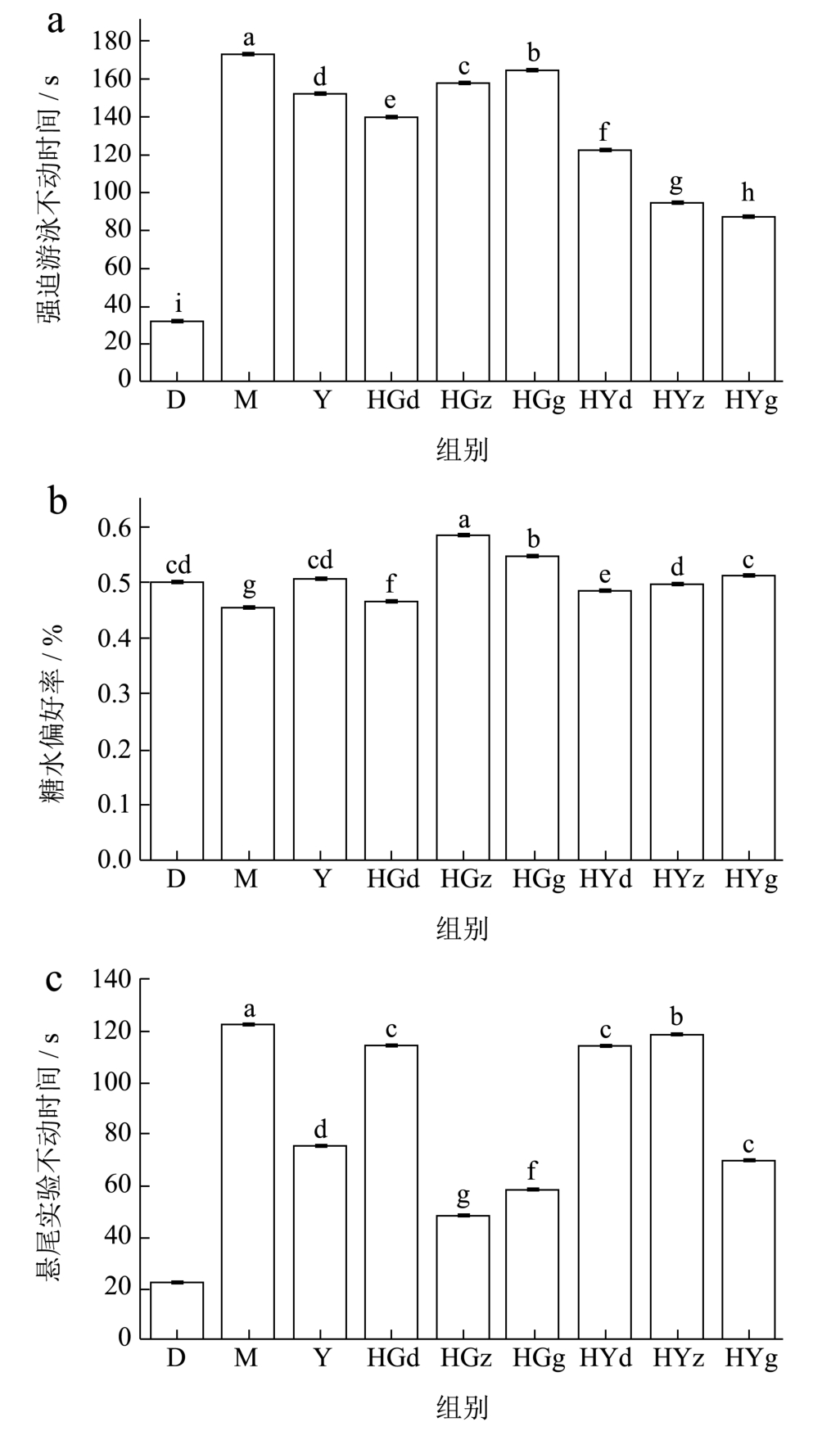
图1 黑果多酚提取物对小鼠行为的影响
Fig.1 Effects of polyphenol extract from Aronia melanocarpa on mice behavior
注:a:Forced swimming test (FST);b:Sucrose preference test (SPT);c:Tail suspension test (TST);不同小写字母表示差异性显著(p<0.05)。
2.2 肠道菌群稀释曲线分析
稀释曲线的数据序列是随机从实验样本中抽取的,本次测序数据量是否足够可根据曲线是否达到平缓来判断[32]。图2所示,在所测序列较少时,OTUs的数量显著增加;随着所测序列增加,表明样品中的大多数微生物类群在测序量中得以体现。图3 Shannon指数呈现平缓趋势,表明取样合理。从图2、图3可以看出,模型组Shannon值与Sobs值显著高于空白组,表明抑郁症促使小鼠肠道菌群的多样性水平上升。与模型组相比,药物组、HG低、高剂量组与HY中剂量组的Shannon值均显著降低,这表明药物与合适剂量的黑果多酚提取物对降低小鼠肠道菌群多样性具有积极影响。综上,药物与黑果多酚提取物具有调节抑郁症小鼠肠道菌群多样性的作用,但与正常组Sobs值与Shannon值仍存在显著差异,表明药物与黑果多酚提取物并未将抑郁症小鼠肠道菌群多样性完全恢复至正常水平,此外小鼠肠道菌群多样性与黑果果实提取物剂量关系呈现剂量负相关。
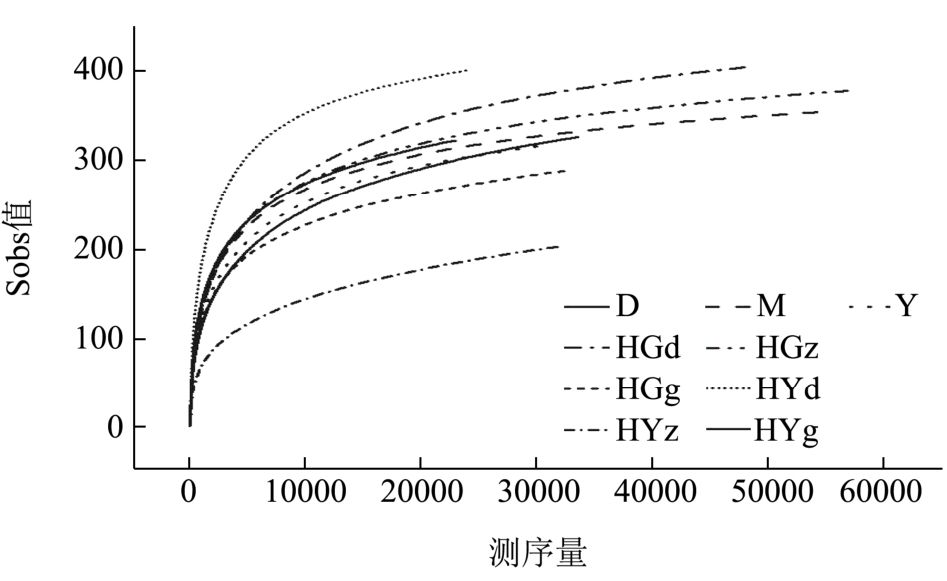
图2 黑果多酚提取物对小鼠肠道菌群稀释曲线的影响
Fig.2 Effects of polyphenol extract from Aronia melanocarpa on the rarefaction curves of intestinal microflora in mice
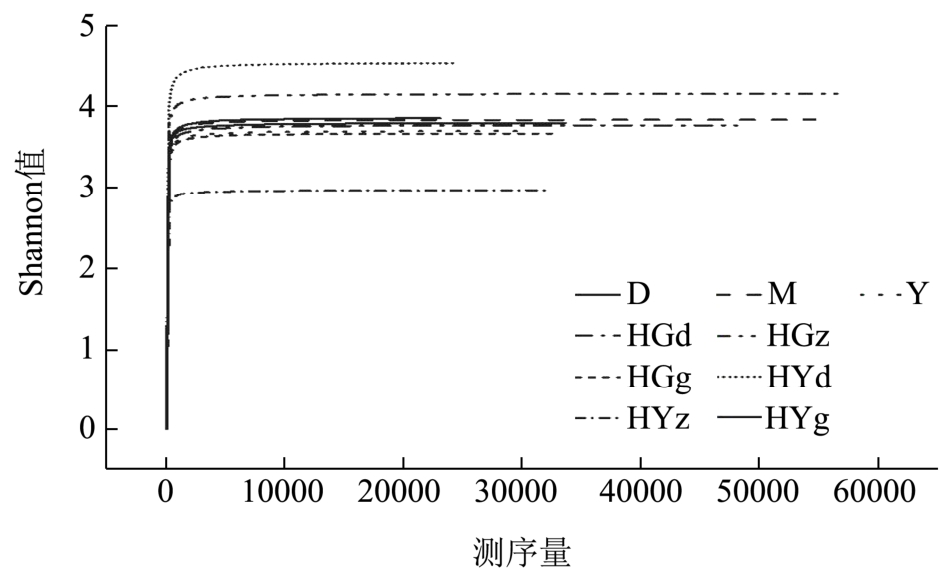
图3 黑果多酚提取物对小鼠肠道菌群Shannon多样性指数的影响
Fig.3 Effects of polyphenol extract from Aronia melanocarpa on Shannon curves of intestinal flora in mice
2.3 Alpha多样性分析
描述Alpha多样性的指标通常有Chao、Ace、Shannon、Simpson等指数,Chao、Ace指数反映样品中群落的丰富度;Shannon、Simpson指数反映群落的多样性[33]。表1结果显示,模型组的Ace值(与正常组相比)明显降低,表明小鼠在抑郁状态下的肠道菌群的丰富度低于正常情况时;而药物组Ace值与Chao值均显著低于模型组,表明药物不具有显著提高抑郁小鼠肠道菌群丰富度的作用。HG低、中剂量组与HY低剂量组与模型组相比丰富度显著提高,表明适当剂量的黑果多酚具有提高抑郁症小鼠肠道菌群丰富度的积极作用;药物组和HG组与空白组丰富度和多样性仍存在显著差异,表明药物和黑果多酚提取物未能将抑郁症小鼠肠道菌群丰富度和多样性调节至正常水平。黑果果实多酚提取物与菌群丰富度呈剂量负相关,且HG高剂量组的小鼠肠道菌群丰富度和多样性与空白组接近。
表1 黑果多酚提取物对小鼠肠道菌群ALPHA多样性分析的影响
Table 1 Effects of polyphenol extracts from Aronia melanocarpa on ALPHA diversity analysis of intestinal flora in mice
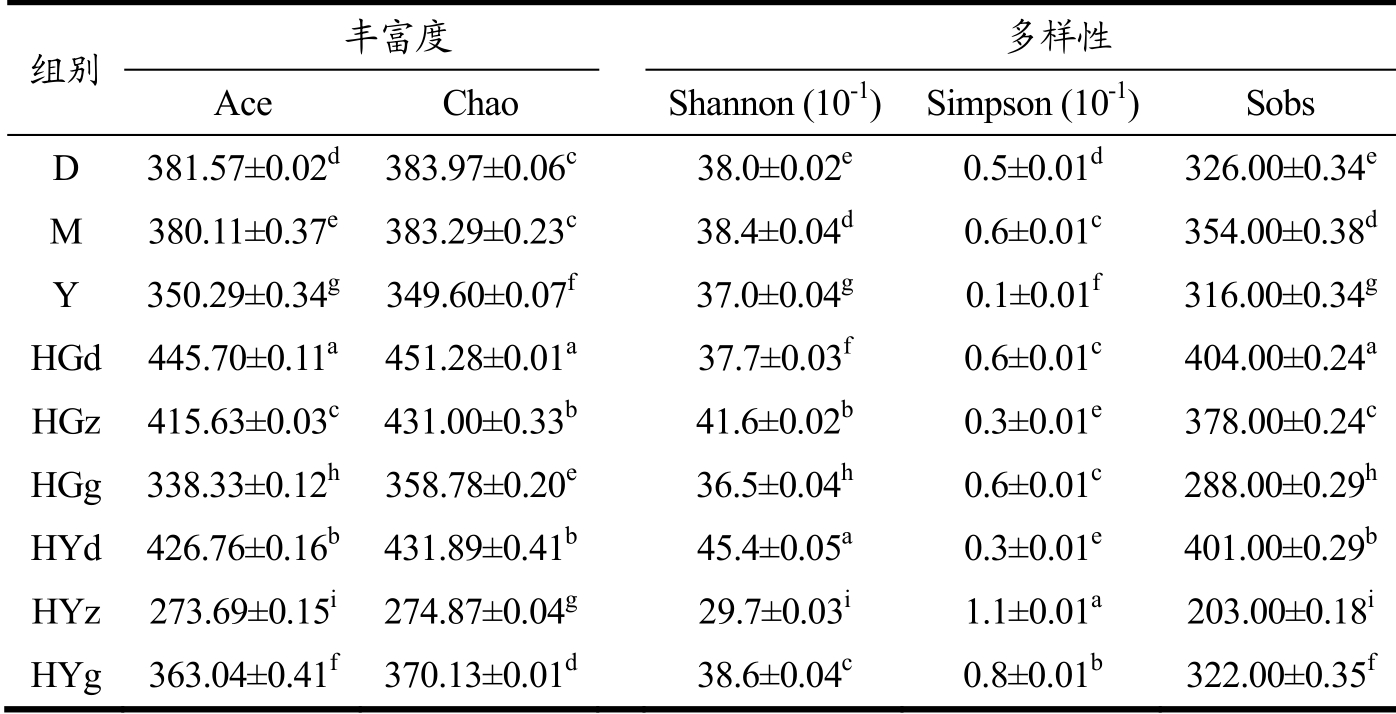
注:不同小写字母表示差异性显著(p<0.05)
组别 丰富度 多样性 Ace Chao Shannon (10-1) Simpson (10-1) Sobs D 381.57±0.02d 383.97±0.06c 38.0±0.02e 0.5±0.01d 326.00±0.34e M 380.11±0.37e 383.29±0.23c 38.4±0.04d 0.6±0.01c 354.00±0.38d Y 350.29±0.34g 349.60±0.07f 37.0±0.04g 0.1±0.01f 316.00±0.34g HGd 445.70±0.11a 451.28±0.01a 37.7±0.03f 0.6±0.01c 404.00±0.24a HGz 415.63±0.03c 431.00±0.33b 41.6±0.02b 0.3±0.01e 378.00±0.24c HGg 338.33±0.12h 358.78±0.20e 36.5±0.04h 0.6±0.01c 288.00±0.29h HYd 426.76±0.16b 431.89±0.41b 45.4±0.05a 0.3±0.01e 401.00±0.29b HYz 273.69±0.15i 274.87±0.04g 29.7±0.03i 1.1±0.01a 203.00±0.18i HYg 363.04±0.41f 370.13±0.01d 38.6±0.04c 0.8±0.01b 322.00±0.35f
由上文与表1结果表明,模型组小鼠的肠道菌群多样性相较于正常组略有提升,实验结果与蒋海寅[34]实验结果基本相同,其提高的原因可能为小鼠体内有害菌种类增加。上述结果表明适当剂量的黑果多酚提取物具有改善抑郁症小鼠肠道菌群失调的功能,与Guo等[35]实验结果相同,多酚对调节肠道菌群平衡,改善健康具有积极作用。
2.4 群落组成测定分析
在门水平,空白组肠道菌群主要由拟杆菌门(Bacteroidetes)、厚壁菌门(Firmicutes)组成,总比例达88.83%,其次为放线菌门(Actinobacterias)。相关研究表明,抑郁症患者肠道菌群与健康人群差异较大[36]。从图5看出,与空白组相比,模型组小鼠肠道菌群拟杆菌门丰度显著提高,厚壁菌门丰度降低,表明抑郁症会改变肠道菌群比例,从而导致菌群失调,与蒋海寅[34]相关临床研究抑郁症患者的菌群结构变化结果基本一致。
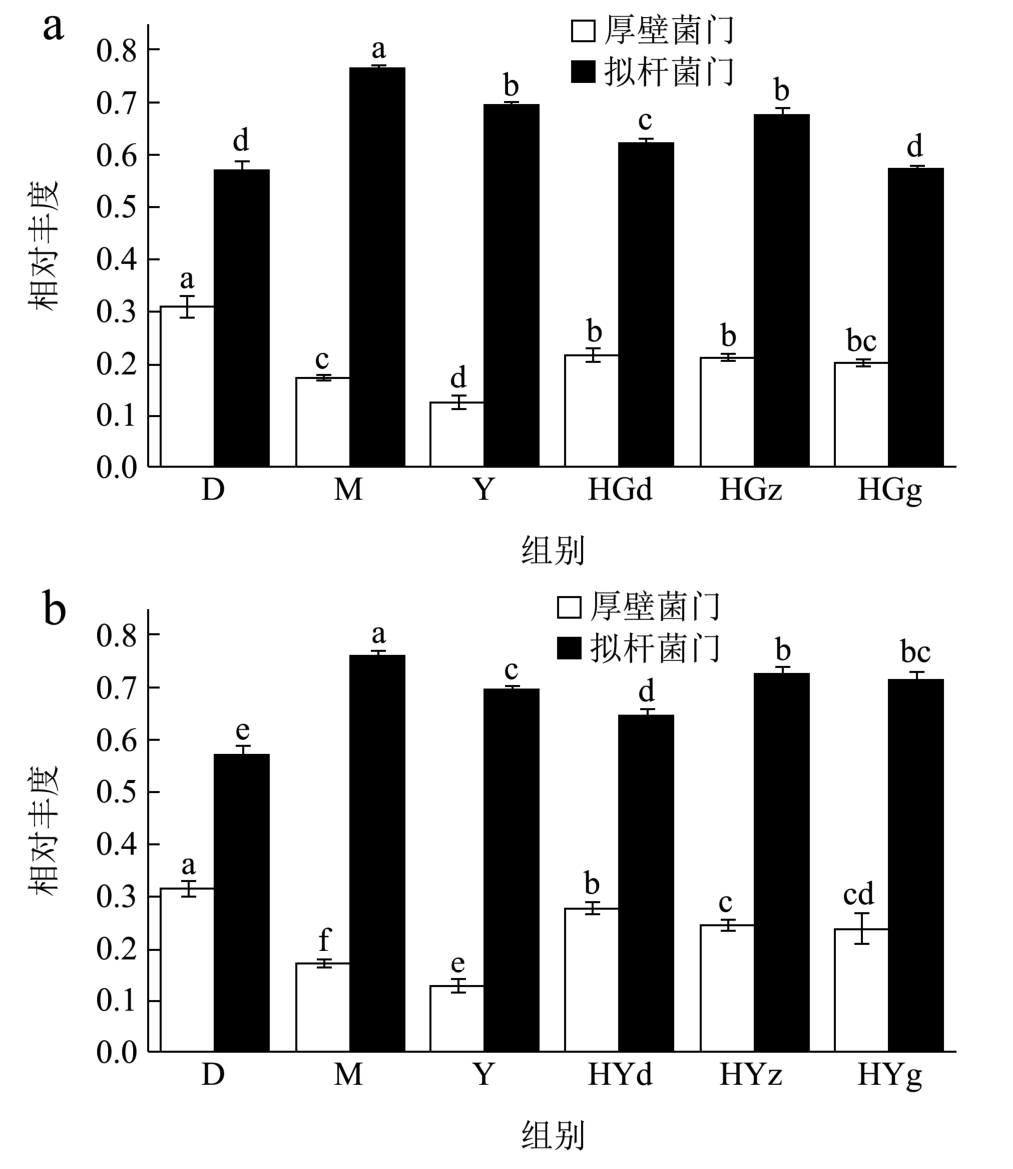
图5 黑果多酚提取物对小鼠肠道中厚壁菌门与拟杆菌门相对丰度的影响
Fig.5 Effects of polyphenol extracts from Aronia melanocarpaon abundance of Firmicutes and Bacteroidetes in intestinal tract of mice
注:a:Fruits of Aronia melanocarpagroup mice;b:Leaves of Aronia melanocarpa group mice。
拟杆菌是一种寄居在人体的肠道中的致病菌,当机体内肠道菌群失调时,可导致感染与炎症等疾病的发生;拟杆菌门中的致病菌prevotella,该菌属细菌表面具有促进人体分泌IL-8mRNA的脂多糖,会加重炎症[37]。从图5看出,药物组、HG组与HY组拟杆菌门的比例均低于模型组,表明黑果多酚提取物与药物具有抑制拟杆菌门的作用;HG高剂量组拟杆菌门比例与空白组差异不显著,表明高剂量的黑果可将抑郁症小鼠拟杆菌比例恢复至正常水平。厚壁菌门中的毛螺菌科参与短链脂肪酸(SCFAs)的代谢生产,SCFAs 可支持肠道上皮组织细胞活动,降低致病菌经由肠粘膜屏障入侵的概率,还可以促进5-HT分泌[38]。HG与HY中厚壁菌门比例均高于模型组,表明黑果中的多酚提取物有益于厚壁菌门的增殖;黑果剂量组厚壁菌门比例与空白组存在显著差异,表明黑果提取物未能将抑郁症小鼠肠道内厚壁菌门比例调节至正常水平;黑果提取物各剂量组厚壁菌门比例差异较小,表明黑果提取物剂量对厚壁菌门丰度无显著影响。从图4可知,与HY组不同,HG组小鼠肠道菌群中均出现疣微菌门。该属中的Akkermansia muciniphila能够产生SCFAs,可为人体提供日常活动所需能量,促进肠道内部健康[39]。综上可得,黑果多酚提取物对肠道菌群组成与丰度具有显著影响,黑果不同部分提取出的多酚对小鼠肠道菌群会产生不同影响,但整体上未能将抑郁小鼠肠道菌群调节至正常平衡状态。

图4 黑果多酚提取物对小鼠门水平下肠道菌群群落组成的影响
Fig.4 Effects of polyphenol extract from Aronia melanocarpa on intestinal microflora community composition at phylum level in mice
注:a:Fruits of Aronia melanocarpa group mice;b:Leaves of Aronia melanocarpa group mice。
2.5 PCA分析
应用主要成分分析(Principal Component Analysis,PCA)所研究的对象是小鼠肠道菌群组成的整体差异,样本物种组成重合度越高,在PCA图中距离越近[40]。图6a表明空白组主要在PC2方向上与其他组产生差异,PC2解释24.93%的差异性,空白组与药物组、HGg组的小鼠肠道菌群组成相似性极高。图6b表明空白组与其他组的差异主要在PC2方向上,PC2可以解释23.83%的差异性,表明空白组与药物组、HYg组的小鼠肠道菌群组成相似性极高。综上,小鼠在抑郁与焦虑状态下肠道菌群失衡,药物与黑果多酚提取物可显著改善抑郁症小鼠肠道菌群紊乱状况,并且高剂量的黑果果实多酚提取物、高剂量的黑果叶子多酚提取物调节抑郁症小鼠肠道菌群的功效最佳。
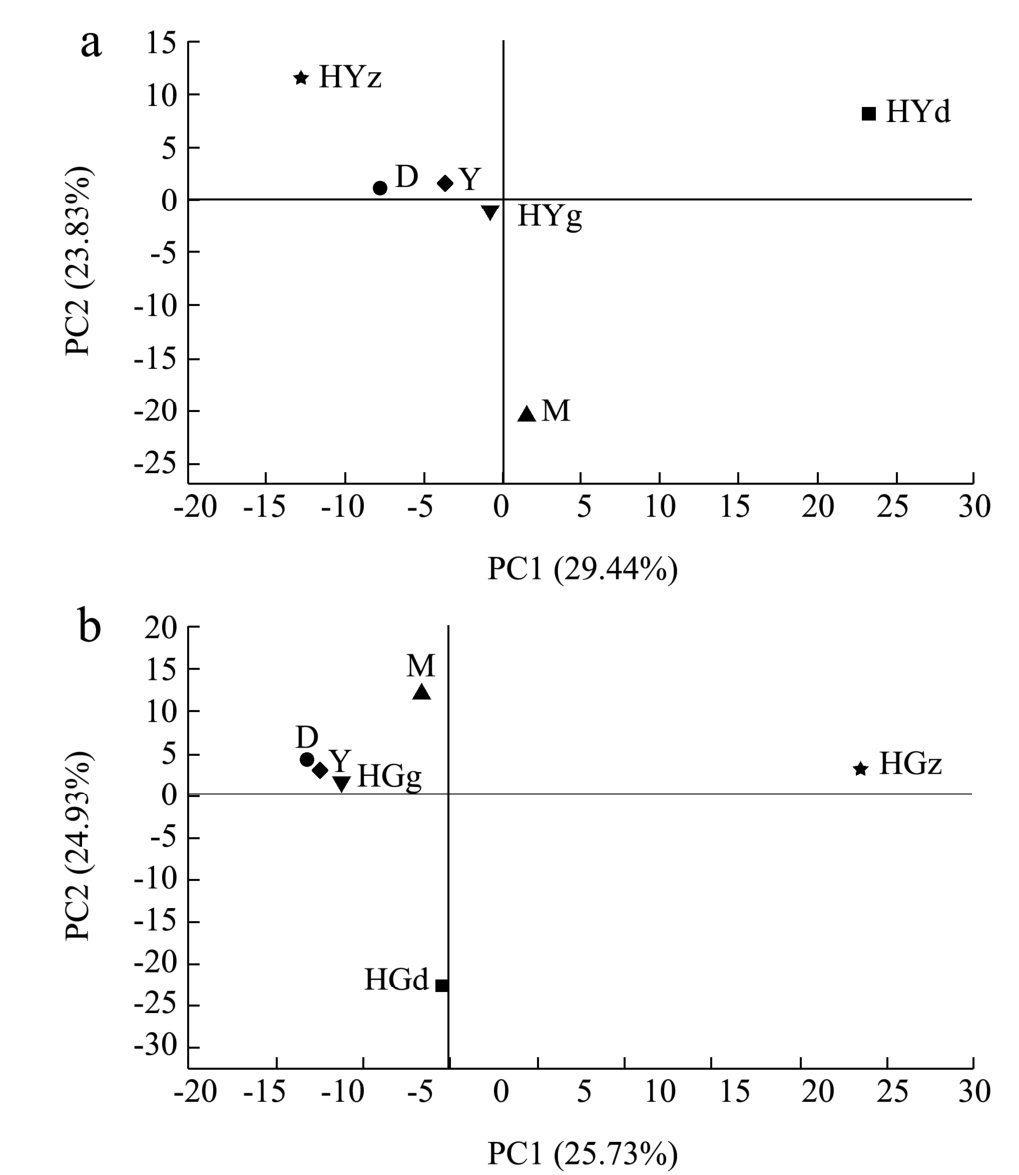
图6 黑果多酚提取物对小鼠肠道菌群PCA分析影响
Fig.6 Effects of polyphenol extract from Aronia melanocarpaon PCA analysis of intestinal flora in mice
注:a:Fruits of Aronia melanocarpa group mice;b:Leaves of Aronia melanocarpa group mice。
2.6 BDNF分析
海马、前额叶和杏仁核发挥着调节情绪与心理应激反应等作用,部分人群在患有抑郁症后,海马和前额叶活动功能受损,杏仁核功能却得到增强,甚至会造成海马萎缩[41]。
从图7、图8可以看出,模型组BDNF表达水平相较于空白组明显降低,抑郁症使小鼠的肠道菌群失衡,菌群的改变诱发了精神紊乱,从而抑制了小鼠海马中BDNF的表达,使其低于正常水平。从图7可以看出,与模型组相比,药物与黑果果实多酚干预后,小鼠BDNF水平显著提高,表明药物与黑果果实多酚提取物有利于BDNF的释放,其中HG中剂量组效果最佳,BDNF水平可显著提高81.39%;HG剂量组BDNF水平显著高于空白组,表明黑果果实多酚提取物还未能将BDNF水平调节至正常水平。从图8看出,与模型组相比,HY组BDNF表达水平均未得到显著上调,表明黑果叶子多酚提取物对于BDNF的释放不具有积极影响。综上可得,黑果果实多酚提取物对大脑海马中BDNF的表达具有显著提高作用,周蓉等也发现多酚可提高抑郁大鼠海马体中BDNF的表达水平[42,43]。黑果果实组小鼠大脑中BDNF水平的提高,可能的原因一方面是由于黑果果实多酚提取物发挥一定的抗氧化作用从而减少了氧化应激对脑神经造成的损害;另一方面则是因为黑果果实多酚提取物将抑郁小鼠的肠道菌群丰富度与多样性恢复到正常水平,因此小鼠大脑中BDNF水平提高了[44]。
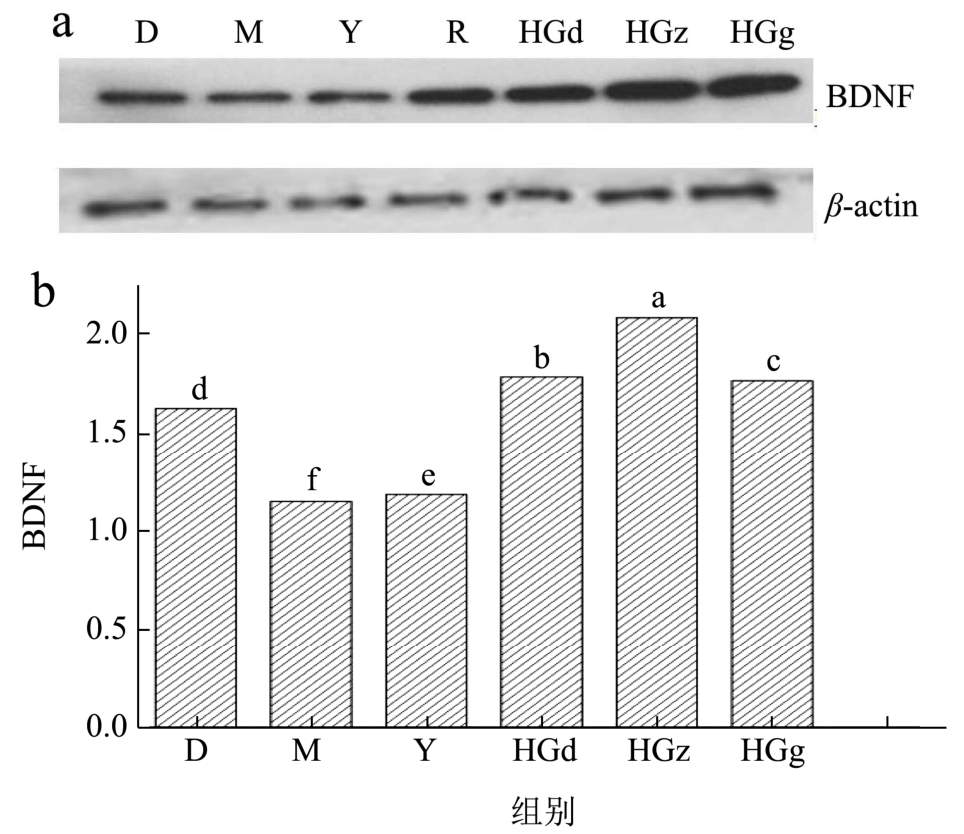
图7 黑果果实多酚提取物对小鼠BDNF表达的影响
Fig.7 Effects of polyphenol extracts from fruits of Aronia melanocarpa on Western blot results of BDNF in mice
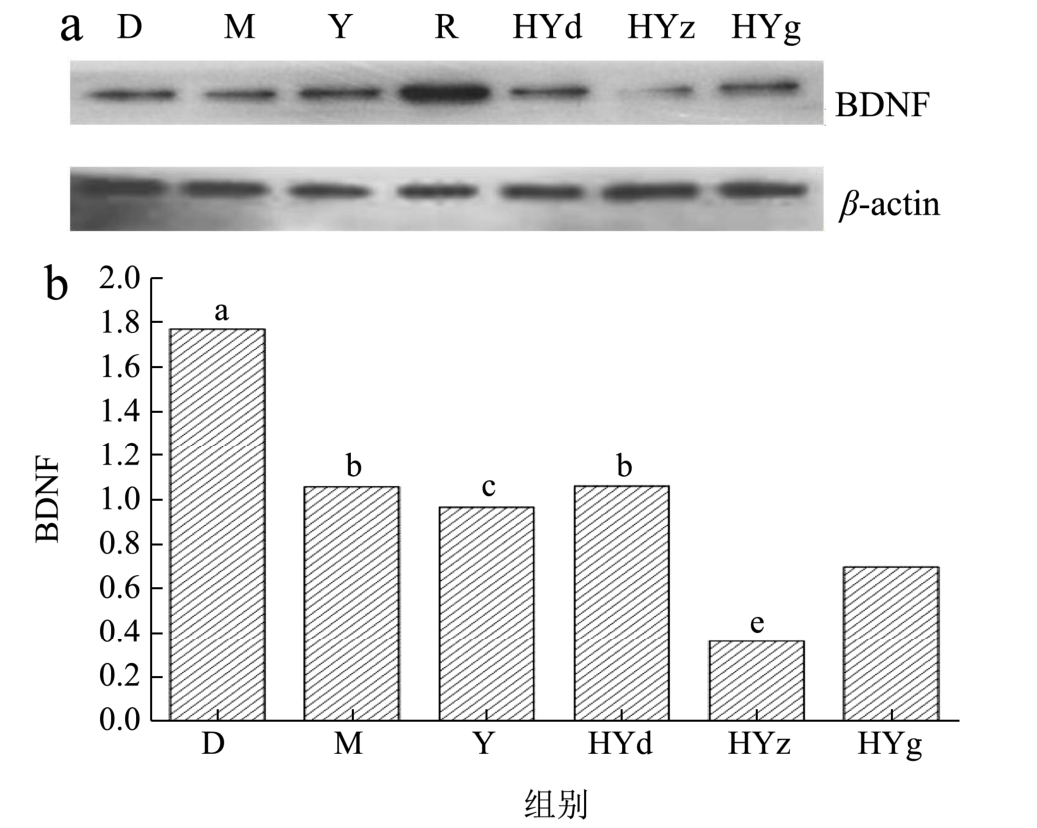
图8 黑果叶子多酚提取物对小鼠BDNF表达的影响
Fig.8 Effects of polyphenol extracts from leaves of Aronia melanocarpa on Western blot results of BDNF in mice
3 结论
3.1 通过本研究发现抑郁症使得正常小鼠的肠道菌群发生显著变化:肠道菌群多样性显著降低,拟杆菌门比例显著提高31.03%,厚壁菌门比例降低45.16%;大脑中BDNF水平显著降低35.23%。黑果果实、叶子多酚提取物干预抑郁症小鼠后,肠道菌群多样性可显著提高18.23%;黑果果实多酚提取物干预抑郁症小鼠后,小鼠脑内BDNF表达显著增强81.39%。
3.2 综上所述,本研究探索了黑果叶子、果实的多酚提取物调节抑郁症小鼠模型的作用关系和菌群机制。结果表明黑果多酚对抑郁症具有一定的调节效果,黑果可作为功能性食品干预调节抑郁症。本文为进一步合理利用黑果、提高黑果的科技含量、开发功能性食品提供一定的理论基础。
[1] 曹程,肖钧元,刘梦秋,等.中药复方开心散调控神经营养因子抗抑郁物质基础与作用机制研究[J].世界科学技术-中医药现代化,2018,20(6):847-855
CAO Cheng, XIAO Junyuan, LIU Mengqiu, et al. Study on material basis and action mechanism of chinese formula Kai-Xin-San on anti-depression via regulation of neurotrophic factors [J]. Modernization of Traditional Chinese Medicine and Materia Medica-World Science and Technology, 2018, 20(6): 847-855
[2] Fiedorowicz J G, Ellingrod V L, Kaplan M J, et al. The development of depressive symptoms during medical internship stress predicts worsening vascular function [J]. Journal of Psychosomatic Research, 2015, 79(3): 243-245
[3] Majd M, Saunders E F H, Engeland C G. Inflammation and the dimensions of depression: a review [J]. Frontiers in Neuroendocrinology, 2020, 56: 100800
[4] 张珊,赵静洁,李丽.免疫炎症与抑郁症[J].中华行为医学与脑科学杂志,2019,28(7):660-665
ZHANG Shan, ZHAO Jingjie, LI Li, et al. Immune inflammation and major depression disorder [J]. Chinese Journal of Behavioral Medicine and Brain Science, 2019, 28(7): 660-665
[5] 王翠竹.桔梗不同部位化学成分及抗抑郁作用的研究[D].长春:吉林大学,2018
WANG Cuizhu. Studies on chemical constituents and antidepressant effect of different parts from Platycodon grandiflorum [D]. Changchun: Jilin University, 2018
[6] 许腾,王艳,卢聪,等.黄花菜改善模拟微重力所致大鼠抑郁的尿液代谢组学研究(英文)[J]. 中国药学, 2020,29(3):176-191
XU Teng, WANG Yan, LU Cong, et al. Urinary metabolomics analysis of the anti-depressive effects of Hemerocallis citrina extracts in a simulated microgravity-induced rat model of depression [J]. Journal of Chinese Pharmaceutical Sciences, 2020, 29(3): 176-191
[7] 孙婷婷.肉豆蔻挥发油抗抑郁作用及机制研究[D].郑州:河南中医学院,2014
SUN Tingting. Study on antidepressant effect and mechanism of nutmeg volatile oil [D]. Zhengzhou: Henan University of Chinese Medicine, 2014
[8] 贾高瞻.铁皮石斛水提物对高脂饮食小鼠肠道菌群的影响[D].广东药科大学,2016
JIA Gaozhan. Influence of aqueous extract of Dendrobium on the changes of intestinal flora of fat diet mice [D]. Guangdong University of Chinese Medicine, 2016
[9] 方正.通过16S rRNA序列分析探讨抑郁症与肠道菌群之间的相互联系[D].重庆:重庆医科大学,2016
FANG Zheng. Explore the relationship between the major depressive disorder and the gut microbiota by 16S rRNA sequences analysis [D]. Chongqing: Chongqing Medical University, 2016
[10] 叶飞,郑鹏,谢鹏.抑郁症肠道微生物组紊乱假说的现状与展望[J].中国实验动物学报,2017,25(6):654-657
YE Fei, ZHENG Peng, XIE Peng. Hypothesis and prospects of disturbed gut microbiota in major depressive disorder [J]. Acta Laboratorium Animalis Scientia Sinica, 2017, 25(6): 654-657
[11] 张银,闻俊,周婷婷.肠道微生物多样性与神经系统疾病[J].中国药理学通报,2019,35(5):597-602
ZHANG Yin, WEN Jun, ZHOU Tingting. Gut microbial diversity and neurological diseases [J]. Chinese Pharmacological Bulletin, 2019, 35(5): 597-602
[12] 陈凤,王龙娟,李贞贞,等.大鼠肠道菌群变化影响其大脑海马脑源性神经营养因子的表达[J].中国微生态学杂志,2015,27 (1):10-13
CHEN Feng, WANG Longjuan, LI Zhenzhen, et al. The changes of intestinal microbiota affect the expression of brain-derived neurotropic factor in rat hippocampus [J]. Chinese Journal of Microecology, 2015, 27(1): 10-13
[13] 梁姗,吴晓丽,胡旭,等.抑郁症研究的发展和趋势-从菌-肠-脑轴看抑郁症[J].科学通报,2018,63(20):2010-2025
LIANG Shan, WU Xiaoli, HU Xu, et al. The development and tendency of depression researches: viewed from the microbiota-gut-brain axis [J]. Chinese Science Bulletin, 2018, 63(20): 2010-2025
[14] Li Nannan, Wang Qi, Wang Yan, et al. Oral probiotics ameliorate the behavioral deficits induced by chronic mild stress in mice via the gut microbiota-inflammation axis [J]. Frontiers in Behavioral Neuroscience, 2018, 12: 266
[15] 徐艳阳,仇洋,王君旸,等.黑果腺肋花楸多酚的抑菌效果及对α-淀粉酶活性的抑制作用[J].食品科学,2018,39(19):51-57
XU Yanyang, QIU Yang, WANG Junyang, et al. α-Amylase inhibitory activity and antibacterial activity of polyphenols from Aronia melanocarpa berries [J]. Food Science, 2018, 39(19): 51-57
[16] 位路路,林杨,王月华,等.黑果腺肋花楸花色苷提取工艺优化及其抗氧化活性和组成鉴定[J].食品科学,2018,39(12):239- 246
WEI Lulu, LIN Yang, WANG Yuehua, et al. Optimization of extraction of anthocyanins from berries of Aronia melanocarpa and their antioxidant activity and composition [J]. Food Science, 2018, 39(12): 239-246
[17] Ramos-Hryb, Ana B. Natural polyphenols and terpenoids for depression treatment: current status [J]. Studies in Natural Products Chemistry, 2017, 55: 181-221
[18] Petko D, Maria K, Milan C, et al. Antioxidant, antimicrobial and neutrophil-modulating activities of herb extracts [J]. Acta Biochimica Polonica, 2014, 61(2): 359-367
[19] Donoso F, Egerton S, Bastiaanssen T F S, et al. Polyphenols selectively reverse early-life stress-induced behavioural, neurochemical and microbiota changes in the rat [J]. Psychoneuroendocrinology, 2020, 116: 104673
[20] 刘艳怀,尹俊涛,雷勇,等.黑果腺肋花楸黑枸杞复合饮料工艺研究[J].农产品加工,2020,10:48-51
LIU Yanhuai, YING Juntao, LEI Yong, et al. Processing technology of composite beverage with Aronia melanocarpa and Lycium ruthenicum Murr [J]. Farm Products Processing, 2020, 10: 48-51
[21] 杨婧娀,王佐民,赵云财.黑果腺肋花楸发酵酒[J].酿酒,2020, 47(1):121-123
YANG Jingsong, WANG Zuomin, ZHAO Yuncai. Aronia melanocarpa wine [J]. Liquor Making, 2020, 47(1): 121-123
[22] Takuya Yamane, Miyuki Kozuka, Momoko Imai, et al. Reduction of blood pressure by aronia berries through inhibition of angiotensin-converting enzyme activity in the spontaneously hypertensive rat kidney [J]. Functional Foods in Health and Disease, 2017, 7(4): 280-290
[23] Azusa Takahashi, Hisae Shimizu, Yukako Okazaki, et al. Anthocyanin-rich phytochemicals from Aronia fruits inhibit visceral fat accumulation and hyperglycemia in high-fat diet-induced dietary obese rats [J]. Journal of Oleo Science, 2015, 64(12): 1243-1250
[24] Katarina Šavikin, Gordana Zdunić, Teodora Janković, et al. Berry fruit teas: phenolic composition and cytotoxic activity [J]. Food Research International, 2014, 62: 677-683
[25] 李巨秀,李利霞,曾王旻,等.燕麦多酚化合物提取工艺及抗氧化活性的研究[J].中国食品学报,2010,10(5):14-21
LI Juxiu, LI Lixia, ZENG Wangmin, et al. Studies on polyphenol extraction and antioxidant activities in oat [J]. Journal of Chinese Institute of Food Science and Technology, 2010, 10(5): 14-21
[26] JI Weiwei, LI Ruipeng, LI Meng, et al. Antidepressant-like effect of essential oil of Perilla frutescens in a chronic, unpredictable, mild stress-induced depression model mice [J]. Chinese Journal of Natural Medicines, 2014, 12(10): 753-759
[27] Azadeh Mesripour, Fatima Alhimma, Valiollah Hajhashemi. The effect of vitamin B6 on dexamethasone-induced depression in mice model of despair [J]. Nutritional Neuroscience, 2019, 22(10): 744-749
[28] 王睿,王琪,金明顺,等.白藜芦醇对围绝经期抑郁症模型小鼠行为及Wnt/β-catenin信号通路主要蛋白表达的影响[J].神经解剖学杂志,2017,33(6):718-722
WANG Rui, WANG Qi, JING Mingshun, et al. The effects of resveratrol on the of behavior and protein expression related to Wnt/β-catenin signaling pathway in mouse model of perimenopausal depression [J]. Chinese Journal of Neuroanatomy, 2017, 33(6): 718-722
[29] 王赛,孙婉婷,王猛,等.豌豆低聚肽对2型糖尿病小鼠肝脏PI3K/AKT/FOXO1信号通路的调节作用[J].现代食品科技, 2021,37(2):21-27
WANG Sai, SUN Wanting, WANG Meng, et al. Regulatory effect of pea oligopeptide on PI3K/AKT/FOXO1 signaling pathway in liver of type 2 diabetic mice [J]. Modern Food Science and Technology, 2021, 37(2): 21-27
[30] 任荔,陶伟伟,柴毅,等.栀子石油醚有效部位的快速抗抑郁潜力与BDNF、p-eEF2的表达上调相关[J].中国药理学通报, 2016,32(9):1224-1230
REN Li, TAO Weiwei, CHAI Yi, et al. Potent rapid antidepressant effects of effective fraction of GJ-PE and up-regulation of BDNF and TrkB [J]. Chinese Pharmacological Bulletin, 2016, 32(9): 1224-1230
[31] 付小彬,缑灵山,何冬梅,等.茶多酚改善慢性不可预知应激小鼠抑郁症状的作用[J].茶叶科学,2013,33(4):301-305
FU Xiaobin, HOU Linshan, HE Dongmei, et al. The antidepressant effect of tea polyphenols to the chronic unpredictable stress induced depressive mice [J]. Journal of Tea Science, 2013, 33(4): 301-305
[32] 杜慧慧,汪开拓,王富敏,等.基于高通量测序分析不同品种柠檬NFC果汁的微生物多样性[J].食品科技,2021,46(3):302-307
DU Huihui, WANG Kaituo, WANG Fumin, et al. Microbial diversity analysis of different lemon NFC juice using high-throughput sequencing [J]. Food Science and Technology, 2021, 46(3): 302-307
[33] Schloss Patrick D, Westcott Sarah L, Ryabin Thomas, et al. Introducing mothur: open-source, platform-independent, community-supported software for describing and comparing microbial communities [J]. Applied and Environmental Microbiology, 2009, 75(23): 7537-7541
[34] 蒋海寅.人类肠道微生物群落菌群多样性变化与抑郁症的相关性研究[D].杭州:浙江大学,2015
JIANG Haiyin. Diversity of gut microbiota associated with patients with major depressive disorder [D]. Hangzhou: Zhejiang University, 2015
[35] Guo X, Cheng M, Zhang X, et al. Green tea polyphenols reduce obesity in high-fat diet-induced mice by modulating intestinal microbiota composition [J]. International Journal of Food ence & Technology, 2017, 52(8): 1723-1730
[36] Liu Y, Zhang L, Wang X, et al. Similar fecal microbiota signatures in patients with diarrhea-predominant irritable bowel syndrome and patients with depression [J]. Clin Gastroenterol Hepatol, 2016, 14(11): 1602-1611
[37] 肖慧,刘艳霞,征征,等.基于16S rRNA测序技术初步探讨多囊卵巢综合征大鼠肠道菌群多样性[J].疑难病杂志,2020,19 (4):399-405
XIAO Hui, LIU Yanxia, ZHENG Zheng, et al. The preliminary study of gut microbiota in polycystic ovary syndrome rat model by 16S rRNA technique [J]. Chinese Journal of Difficult and Complicated Cases, 2020, 19(4): 399-405
[38] ZHAO Liping, ZHANG Feng, DING Xiaoying, et al. Gut bacteria selectively promoted by dietary fibers alleviate type 2 diabetes [J]. Science, 2018, 359(6380): 1151-1156
[39] 赵凡,李春保.肠道菌Akkermansia muciniphila的特性及其与机体健康的关系[J].微生物学通报,2017,44(6):1458-1463
ZHAO Fan, LI Chunbao. Characteristics of intestinal bacterium Akkermansia muciniphila and the association with host health [J]. Microbiology China, 2017, 44(6): 1458-1463
[40] 麻和平,张文齐,刘彩云,等.高通量测序分析比较不同保存温度下牦牛酸奶细菌多样性[J].中国酿造,2021,40(3):129-133
MA Heping, ZHANG Wenqi, LIU Caiyun, et al. Analysis and compare of bacterial diversity in yak yogurt at different storage temperatures by high-throughput sequencing [J]. China Brewing, 2021, 40(3): 129-133
[41] 王凡,张晨,方贻儒.Ras信号通路与抑郁症神经可塑性机制[J].上海交通大学学报(医学版),2015,35(10):1556-1559
WANG Fan, ZHANG Chen, FANG Yiru. Ras signaling pathway and neural plasticity mechanism of depression [J]. Journal of Shanghai Jiaotong University (Medical Science), 2015, 35(10): 1556-1559
[42] 周蓉.肝郁脾虚型抑郁症大鼠海马和肠道BDNF及其受体TRKB表达与逍遥散干预研究[D].武汉:湖北中医药大学, 2019
ZHOU Rong. Research on the expressions of BDNF and its receptor TRKB in hippocampi and intestines of depression model rats of syndrome of liver stagnation and spleen deficiency and intervention of Xiaoyao powder [D]. Wuhan: Hubei University of Traditional Chinese Medicine, 2019
[43] 安改红,陈学伟,王静,等.姜黄素预处理对慢性心理应激大鼠中枢神经的保护作用[J].解放军预防医学杂志,2013,31(1): 16-19
AN Gaihong, CHEN Xuewei, WANG Jing, et al. Neuroprotective effect of curcmin on rats under chronic unpredictable mild stress [J]. Journal of Preventive Medicine of Chinese People's Liberation Army, 2013, 31(1): 16-19
[44] 李孟秋.黄秋葵种子抗抑郁活性及机制研究[D].天津:天津科技大学,2016:20-30
LI Mengqiu. Stduy on anti-depressant activity of okra seed and related mechanism in mice [D]. Tianjin: Tianjin University of Science and Technology, 2016: 20-30